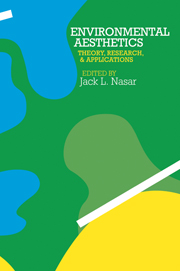Preface
Published online by Cambridge University Press: 05 September 2013
Summary
Background
Environmental aesthetics represents the merging of two areas of inquiry: empirical aesthetics and environmental psychology. Both areas use scientific methodologies to help explain the relationship between physical stimuli and human response. Empirical aesthetics is concerned with the arts (painting, music, literature, and dance), and environmental psychology is an applied field concerned with improving the quality of the human habitat. By combining a concern with aesthetic value, a problem focus on human habitat, and a methodological emphasis on applicability, environmental aesthetics becomes a unique endeavor. One notable factor is the use of a broader definition of aesthetics (see Wohlwill, 1976) to include environmental influences on the whole range of human affect. Thus central concerns in environmental aesthetics include understanding environmental influences on affect and translating that understanding into environmental design that is judged favorably by the public.
Although aesthetics is only one among a host of considerations in environmental design, it is an important one. The aesthetic quality of the surroundings may affect immediate experience – sense of well-being – in those surroundings; it may influence subsequent reactions to both the setting and its inhabitants; and it may influence spatial behavior in that individuals are attracted to an appealing environment and are likely to avoid an unpleasant one. With knowledge of the relationship between properties of the visual environment and human affect, design professionals can better plan, design, and manage settings to fit the preferences and activities of the users. This, in turn, may contribute to enhancing the quality of life.
- Type
- Chapter
- Information
- Environmental AestheticsTheory, Research, and Application, pp. xxi - xxviiiPublisher: Cambridge University PressPrint publication year: 1988



